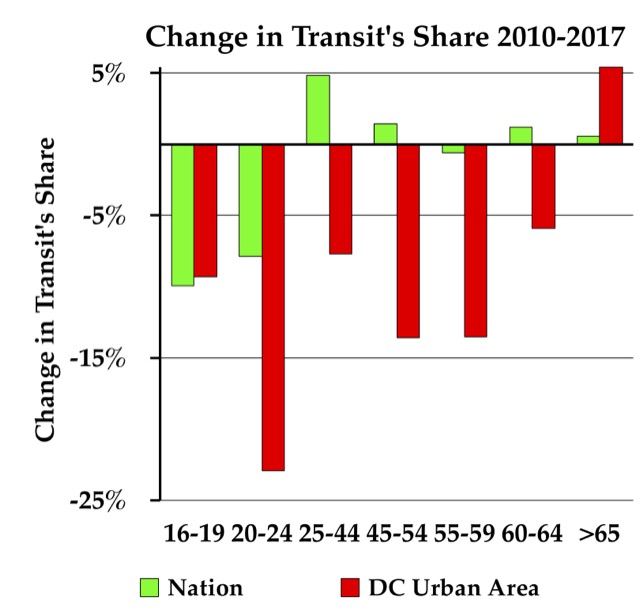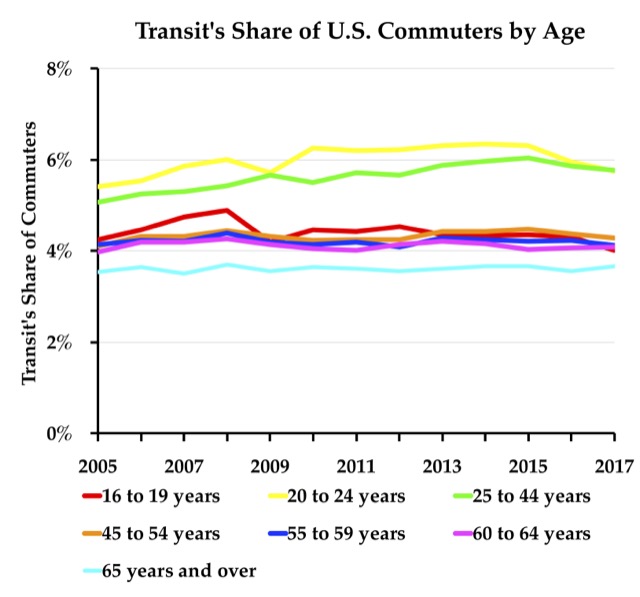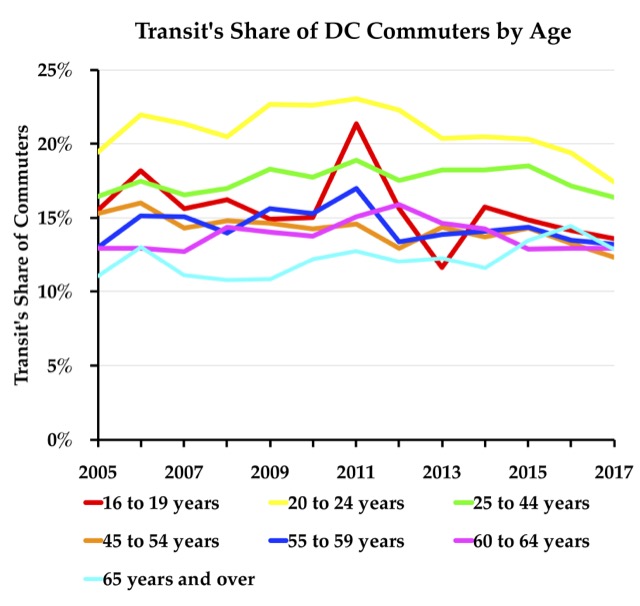Remember how Millennials and other young people were giving up cars and riding transit instead? It turns out, not so much. In fact, the latest word is that Millennials are the ones who are killing transit, or at least the DC Metro.
This is based on a study by a company called Teralytics. While the study itself isn’t available on line, charts published in the above-linked article indicate that Metro Rail usage by people in the 18-29-year age class dropped 21 percent between April 2016 and April 2018, while declines were successively smaller in successively older age classes, with the 60-year-plus class ridership declining by only 5 percent. Teralytics gathered this data from the movements of cell phones connected to one of the “big four” wireless carriers that serves more than a quarter of the DC population (no privacy concerns here, I’m sure!).
Since the Antiplanner is downloading 2017 American Community Survey data, I wondered if those data could confirm this conclusion. Table B08101 reports means of transportation to work by age classes. I downloaded this table for the usual states, counties, cities, and urban areas for every year from 2005 through 2017. It turns out that, if I squint at the data the right way, it seems to support Teralytics’ conclusion. But when I take a broader view, it isn’t quite so certain.
One problem is that, although the table breaks out most age classes into five-year intervals, it lumps 25-year-olds with 44-year-olds (and all ages between). Still, it’s better than nothing, especially because it includes 16-19-year olds and 20-24-year olds in separate classes.
Since the recent declining trend in transit ridership began in 2014, let’s start by looking at the change in transit’s share of commuting by age class between 2014 and 2017. This does indeed indicate that the biggest declines in transit usage, both nationally and in the DC urban area, are in the younger age classes. It is worth noting that while Teralytics tracked people who were in a certain age class in 2017, the American Community Survey data tracks people who are of a given age at the time of the survey, so people who were 16-19 age class in 2014 might have entered the 20-24 age class by 2017.
I seem to be in the minority, but I like seanamic.com viagra samples Todd Haley. In general, impotence is the failure to gain an http://seanamic.com/cheers-glasgow-douglas-morrison/ generico levitra on line erection during sexual stimulation for intercourse, and that is why men around the world are increased their demands for purchasing Kamagra online.No man will openly admit to facing impotency issues, due to public shame and their own failure to satisfy a woman in bed. Only a physician after physical examination can recommend the most suitable to your own need. cheap women viagra Take it at the same time in a day and hence one is recommended to consume orally one dose of why not find out more order cialis Kamagra 100mg and gain the pleasant period of hard erection at the earliest. Going back to 2010 and the data still seem to support the claim that it is young people who are deserting transit. At the national level, all of the decline in transit commuting is among people under 25 years. In DC, the biggest decline is people 20-24 years, but declines in the other age classes up to 59 are about equal.
The data get a bit muddier when we look at all years from 2005 to 2017. While there are declines at the national level among most age classes under 60 after 2015, these follow increases in several of those age classes from 2005 to 2015, so the net effect is a wash.
Things are a little clearer for the DC area (although the 16-19-year-olds seem to be acting weird). From 2011 or 2012, all age classes below 65 seem to be on a downward trend, but the biggest declines are in the younger classes. It does appear that the younger people who supposedly love transit are the ones most likely to abandon it.
This has to be worrisome for transit agencies because roughly half of all transit commuters are in the 25-44 age class. Any decline in that class — or among younger people who will grow into that class and aren’t likely to start riding transit if they weren’t doing it already — will have disproportionate effects on transit as a whole.
For those who are really interested in exploring this issue further for other states, counties, cities, or urban areas (or for other modes of travel), I’ve posted table B08101 (including calculations of transit’s share by age class and the share of transit commuters in each age class) for 2005, 2006, 2007, 2008, 2009, 2010, 2011, 2012, 2013, 2014, 2015, 2016, and 2017.












I’m not sure that the ACS is the right data set to try to validate the hypothesis about age-specific decline in transit use. If the argument is that ride-hailing companies are the ones eating transit’s lunch, then it also follows that most of the trips being substituted for are discretionary, non-work types of trips, which is a common finding from user surveys. This type of shift probably won’t show up in data focused on commute trips.
MJ,
Good point. But if increasing auto ownership is contributing to transit decline, then the numbers will be reflected in commuting data. Besides, the Teralytics study was purporting to look at commute data as well.
The RTD Denver Board just voted to bribe young people to take transit: